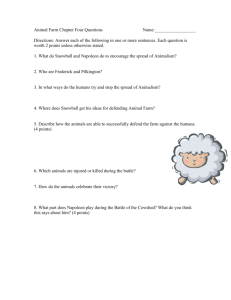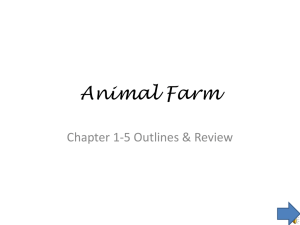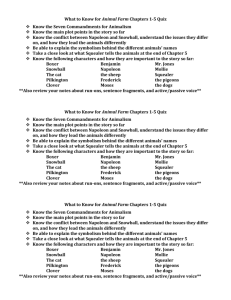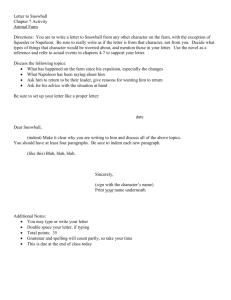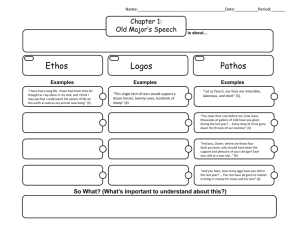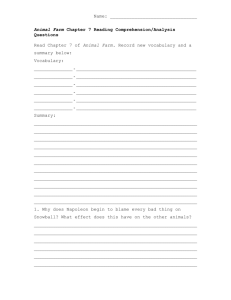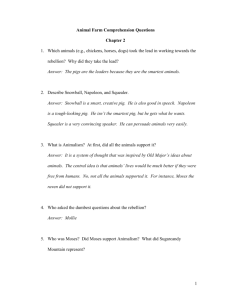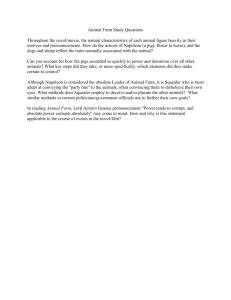Animal Farm: Chapters 1-5 Outline & Review
advertisement
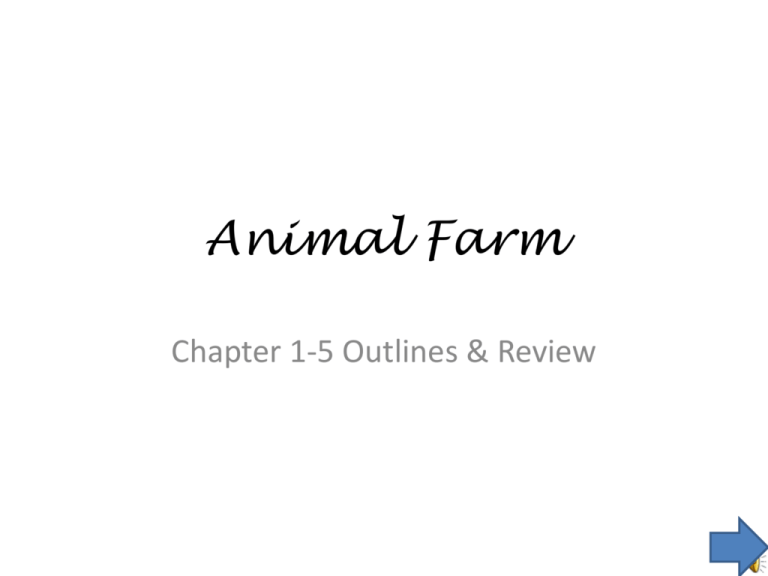
Animal Farm Chapter 1-5 Outlines & Review Main Menu Chapter Outlines Chapter 1 Chapter 2 Chapter 3 Chapter 4 Chapter 5 Review Directions (READ THEM!) Question 1 Question 2 Question 3 Chapter 1 • Animal Farm is an extended metaphor for Russian Revolution • Old Major = Agent of change o Dream presents animals with utopia • Humans = Oppressors • Common animals cannot bridge gap between reality and utopia • “Beasts of England” broken down: o Lofty Rhetoric o Speaks of breaking free o Animals believe fully in lyrics Chapter 2 • Napoleon (notice the name!), Snowball and Squealer Animalism= Socialism o Squealer creates propaganda o Biggest problem = Moses (notice the name!) — Tells tales of “Sugarcandy Mountain” — Represents heaven — Parallels between Moses in bible Delivers slaves through god/heaven • Boxer and Clover = working class • Mollie is frivolous o Doesn’t want to lose privileges o Squealer says “hair bows” represent slavery (this is propaganda) • Commandments are written • Social stratification beginning- Napoleon lags behind while others work Chapter 3 • “Four legs good, two legs bad” o Two legs = humans = oppression o Heart of Animalism according to Snowball • Degrees of literacy varies = social stratification • Squealer pretends to side with oppressed as ploy o Covers pigs greed – “they got us here would they betray us now?” o Form of propaganda • Snowball vs. Napoleon o o o o Strongest/most opinions Always opposing Snowball = democracy Napoleon = communism • Napoleon raises puppies without anyone’s knowledge o Foreshadowing!!!! Popular During War Times Think of it as brainwashing advertisement Chapter 4 • BATTLE ROYALE! o Better known as “Battle of Cowshed” o Humans in adjoining farms battle animals o Represents Russia’s interwar period • Irony! Irony! Irony! o Gap between what they are fighting for and what they THINK they are fighting for o Animals don’t understand principals in place o Only consolidating pigs power not equality Chapter 5 • Snowball vs. Napoleon- becomes escalated • Windmill o o o o o Windmill= technological advances Snowball’s idea: based on readings from books Animals vote on idea Napoleon disagrees but is outnumbered Snowball draws up plans • After plans are finished dogs attack Snowball • Squealer PROPAGANDA…again o Napoleon makes ultimate sacrifice for the farm o Irony: claims snowball was trying to disobey commandments • Attack instills fear of Napoleon o What does this say about Russian government? Question 1 Who reduces the ideas of Animalism to “four legs good, two legs bad?” A. Snowball B. Napoleon C. Squealer D. Boxer Question 2 What is significant about the name of the bird Moses? A. “Sugarcandy Mountain” that he speaks of is like heaven. B. He parts the bushes for the animals to escape like Moses does the red sea. C. He claims to eliminate slavery through the talk of heaven or “Sugarcandy Mountain.” D. He casts plagues upon Animal Farm like Moses did to Egypt. Question 3 Which of the literary terms BEST describes the “Battle of Cowshed?” A. Analogy B. Figure of Speech C. Simile D. Irony SNOWBALL But why? To make it simpler for the animals to remember Click check to continue NAPOLEON Although Napoleon sets himself higher than the other animals he doesn’t come up with the idea for the saying. EXPLANATION OF QUOTE Click Here CHARACERIZATION Click Here Click x mark to Try Again! SQUEALER Squealer’s role is strictly for propaganda. Consider him the farm “gossiper” EXPLANATION OF QUOTE Click Here CHARACERIZATION Click Here Try Again! BOXER Boxer = working class Which means he falls under those that don’t understand the commandments. EXPLANATION OF QUOTE Click Here CHARACERIZATION Click Here Try Again! INCORRECT! Although Moses talks about Sugarcandy Mountain is significant but not what makes his name significant. Try Again! INCORRECT! This never happened! Try Again! CORRECT! Moses = Deliverer through heaven INCORRECT! This never happens! Try Again! ANALOGY Think comparison • Definition: A similarity or comparison between two different things or the relationship between them. • Can explain something unfamiliar by associating it with or pointing out its similarity to something more familiar. Try Again! FIGURE OF SPEECH Think umbrella: Other devices fall under it • Definition: A device used to produce figurative language. • Many compare dissimilar things. • Include: apostrophe, hyperbole, oxymoron etc. Try Again! SIMILE • Definition: Comparison using like or as. Think metaphor but with like/as. Try Again! IRONY • Definition: The contrast between what is stated explicitly and what is really meant. The difference between what appears to be true and what is actually true. • 3 major types: o Verbal o Situational o Dramatic Which type best describes the Battle of Cowshed? (Click answer above) Verbal • The words actually state the opposite of the writer’s true meaning. Try Again! Situational • Events turn out the opposite of what was expected • What the characters/reader thinks ought to happen is not what happens Try Again! Dramatic • Facts or events are unknown to a character in the play or piece of fiction but is known to the reader, audience in other characters in the work. Click Guy to Finish
